View in other NatureServe Network Field Guides
NatureServe
Montana
Utah
Wyoming
Idaho
Wisconsin
British Columbia
South Carolina
Yukon
California
New York
Columbia Slimy Sculpin - Cottus cognatus
General Description
The slimy sculpin is native west of the Continental Divide, and a recent study (Neely 2010) showed through DNA work that the Columbia Basin slimy sculpin is more closely related to a Russian sculpin in Siberia--not the slimy sculpin of the eastern U.S., as some previously thought. Like the rocky mountian sculpin, it prefers clear, cold, rocky streams but will also be found along cobbly shorelines of lakes. Like all sculpins, this species is a benthic invertivore meaning it eats primarily aquatic insects. They occasionally eat small fish or trout eggs but this is not a large part of their diet. All freshwater sculpins are spring spawners. The males select spawning sites on the undersides of rocks. The female is courted, enters the nest, and deposits a mass of adhesive eggs upside down on the ceiling of the nest. The male then guards the nest and newly-hatched young sculpins with vigilance.
Diagnostic Characteristics
The back and sides are brown to black with mottling; dark bands are often present. The underside is white. The first dorsal fin is fringed with orange on breeding males. No palatine teeth are present. Pelvic fins have 3 or 4 soft rays; if a fourth (inner) ray is present, it is usually two-thirds or less the length of the longest. Other Montana sculpins have four fully developed soft rays. Note: sculpin pelvic fins have one spine in addition to the soft rays. It is encased in a fleshy membrane with the first (outer) ray and is not distinct.
Species Range
Montana Range
Range Descriptions
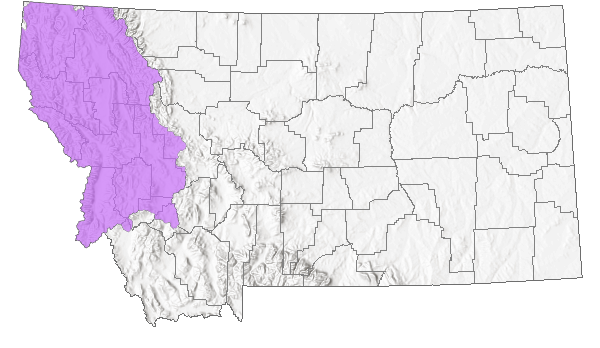
 Native
Native
Western Hemisphere Range
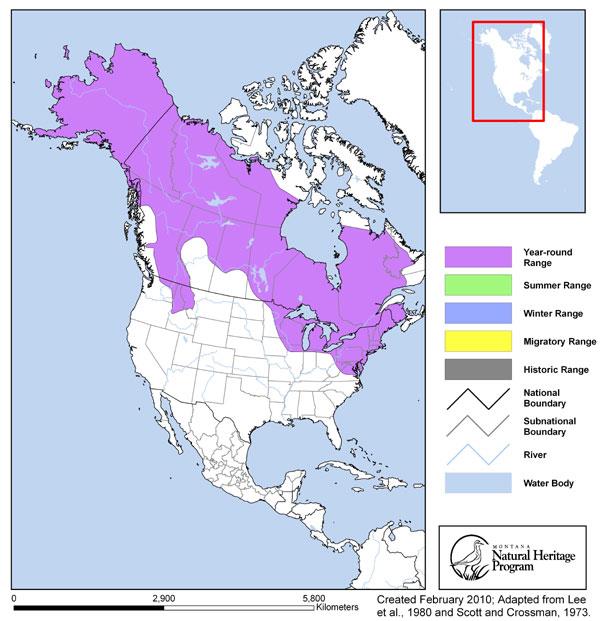
Range Comments
Found throughout western MT in cold, clear rivers and streams.
Observations in Montana Natural Heritage Program Database
Number of Observations: 877
(Click on the following maps and charts to see full sized version)
Map Help and Descriptions
Relative Density
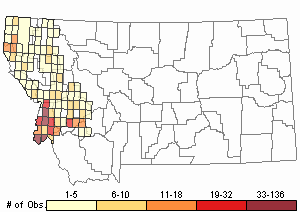
Recency
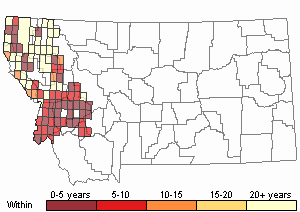

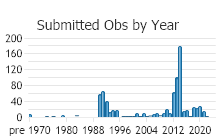
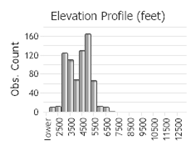 (Observations spanning multiple months or years are excluded from time charts)
(Observations spanning multiple months or years are excluded from time charts)
Habitat
Its usual habitat is in the rocky riffles of cold, clear streams, but it is sometimes found along the rubble beaches of lakes, especially near the mouths of inlet streams (Brown 1971).
Food Habits
Food is comprised of mostly immature aquatic insects and invertebrates, but also includes any small fish available (Brown 1971).
Ecology
Construction of the Libby Dam wiped out populations in a stretch of river now occupied by Lake Koocanusa (Huston 1984).
Reproductive Characteristics
Spawning occurs in spring (Brown 1971). Incubation is in 30-40 days at 48-50 degrees F. They may become sexually mature at 2 years (Weisel 1957). Populations in northern Saskatchewan spawned in early May at 46 degrees F. with eggs hatching in 4 weeks (Scott 1973).
Stewardship Responsibility
References
- Literature Cited AboveLegend:
 View Online Publication
View Online Publication Brown, C.J.D. 1971. Fishes of Montana. Bozeman, MT: Big Sky Books/Montana State University. 207 p.
Brown, C.J.D. 1971. Fishes of Montana. Bozeman, MT: Big Sky Books/Montana State University. 207 p. Huston J.E., P. Hamlin; B. May 1937-; Montana. Dept. of Fish, Wildlife, and Parks.; United States. Army. Corps of Engineers. Seattle District. 1984
Huston J.E., P. Hamlin; B. May 1937-; Montana. Dept. of Fish, Wildlife, and Parks.; United States. Army. Corps of Engineers. Seattle District. 1984 Lee, D.S., C.R. Gilbert, C.H. Hocutt, R.E. Jenkins, D. E. McAllister, J. R. Stauffer, Jr. 1980. Atlas of North American freshwater fishes. North Carolina State Musuem of Natural History. 867 p.
Lee, D.S., C.R. Gilbert, C.H. Hocutt, R.E. Jenkins, D. E. McAllister, J. R. Stauffer, Jr. 1980. Atlas of North American freshwater fishes. North Carolina State Musuem of Natural History. 867 p. Neely, D.A. 2010. Systematics of Montana sculpins, final report on activities conducted during 2009–2010. Tennessee Aquarium Conservation Institute, Cohutta, Georgia.
Neely, D.A. 2010. Systematics of Montana sculpins, final report on activities conducted during 2009–2010. Tennessee Aquarium Conservation Institute, Cohutta, Georgia. Scott, W.B. and E.J. Crossman. 1973. Rainbow trout, Kamloops trout, Steelhead trout Salmo gairdneri Richardson. pp. 184-191. In: Freshwater fishes of Canada. Ottawa, Canada: Fisheries Research Board of Canada, Bulletin 184. 966 p.
Scott, W.B. and E.J. Crossman. 1973. Rainbow trout, Kamloops trout, Steelhead trout Salmo gairdneri Richardson. pp. 184-191. In: Freshwater fishes of Canada. Ottawa, Canada: Fisheries Research Board of Canada, Bulletin 184. 966 p. Weisel, G.F. 1957. Fish guide for intermountain Montana. Montana State University Press. Missoula, MT. 88 pp.
Weisel, G.F. 1957. Fish guide for intermountain Montana. Montana State University Press. Missoula, MT. 88 pp.
- Additional ReferencesLegend:
 View Online Publication
View Online Publication
Do you know of a citation we're missing? Bahn, L. 2007. An assessment of losses of native fish to irrigation diversions on selected tributaries of the Bitterroot River, Montana. M.Sc. Thesis. Bozeman, MT: Montana State University. 118 p.
Bahn, L. 2007. An assessment of losses of native fish to irrigation diversions on selected tributaries of the Bitterroot River, Montana. M.Sc. Thesis. Bozeman, MT: Montana State University. 118 p. Brandt, S. B. 1986. Ontogenetic shifts in habitat, diet and diel-feeding periodicity of slimy sculpin in Lake Ontario. Trans. Am. Fish. Soc. 115:711-715.
Brandt, S. B. 1986. Ontogenetic shifts in habitat, diet and diel-feeding periodicity of slimy sculpin in Lake Ontario. Trans. Am. Fish. Soc. 115:711-715. Brandt, S., and S. Madon. 1986. Rainbow smelt, Osmerus mordax, predation on slimy sculpin, Cottus cognatus, in Lake Ontario. J. Great Lakes Res. 12:322-325.
Brandt, S., and S. Madon. 1986. Rainbow smelt, Osmerus mordax, predation on slimy sculpin, Cottus cognatus, in Lake Ontario. J. Great Lakes Res. 12:322-325. Brandt, Troy M. 2000. Fish diversity behavior and microhabitat use in secondary channels of the Bitterroot River, Montana. M.S. Thesis. University of Montana. Missoula, MT.
Brandt, Troy M. 2000. Fish diversity behavior and microhabitat use in secondary channels of the Bitterroot River, Montana. M.S. Thesis. University of Montana. Missoula, MT. Burford, D.D. 2005. An assessment of culverts of fish passage barriers in a Montana drainage using a multi-tiered approach. M.Sc. Thesis. Bozeman, MT: Montana State University. 50 p.
Burford, D.D. 2005. An assessment of culverts of fish passage barriers in a Montana drainage using a multi-tiered approach. M.Sc. Thesis. Bozeman, MT: Montana State University. 50 p. Cuker, B. E., M. E. McDonald, and S. C. Mozley. 1992. Influences of slimy sculpin (Cottus cognatus) predation on the rocky littoral invertebrate community in an arctic lake. Hydrobiologia 240:83-90.
Cuker, B. E., M. E. McDonald, and S. C. Mozley. 1992. Influences of slimy sculpin (Cottus cognatus) predation on the rocky littoral invertebrate community in an arctic lake. Hydrobiologia 240:83-90. Edson, S.A. 1992. Sculpin (Cottus) distribution in the Kootenai National Forest and northwestern portions of the Flathead National Forest, Montana. Helena, MT: Montana Natural Heritage Program. 37 p.
Edson, S.A. 1992. Sculpin (Cottus) distribution in the Kootenai National Forest and northwestern portions of the Flathead National Forest, Montana. Helena, MT: Montana Natural Heritage Program. 37 p. Gangemi, J.T. 1992. Sculpin (Cottus) distribution in the Kootenai National Forest and western portions of the Lolo National Forest, Montana. Helena, MT: Montana Natural Heritage Program. 54 p.
Gangemi, J.T. 1992. Sculpin (Cottus) distribution in the Kootenai National Forest and western portions of the Lolo National Forest, Montana. Helena, MT: Montana Natural Heritage Program. 54 p. Godkin, C.M., W.J. Christie, and D.E. McAllister. 1982. Problems of species identity in the Lake Ontario sculpins Cottus bairdi and C. cognatus. Can. J. Fish. Aquat. Sci. 39:1373-1382.
Godkin, C.M., W.J. Christie, and D.E. McAllister. 1982. Problems of species identity in the Lake Ontario sculpins Cottus bairdi and C. cognatus. Can. J. Fish. Aquat. Sci. 39:1373-1382. Gregg, R.E., R.F. Leary, and F.W. Allendorf. No date. Morphological and genetic identification and distribution of sculpins in western Montana. Missoula, MT: Division of Biological Sciences, University of Montana. 16 p.
Gregg, R.E., R.F. Leary, and F.W. Allendorf. No date. Morphological and genetic identification and distribution of sculpins in western Montana. Missoula, MT: Division of Biological Sciences, University of Montana. 16 p. Hanson, K. L., A. E. Hershey, and M. E. McDonald. 1992. A comparison of slimy sculpin (Cottus cognatus) populations in arctic lakes with and without piscivorous predators. Hydrobiologia 240:189-201.
Hanson, K. L., A. E. Hershey, and M. E. McDonald. 1992. A comparison of slimy sculpin (Cottus cognatus) populations in arctic lakes with and without piscivorous predators. Hydrobiologia 240:189-201. Hendricks, P. 1997. Status, distribution, and biology of sculpins (Cottidae) in Montana: a review. Unpublished report to USDA Forest Service. 29pp.
Hendricks, P. 1997. Status, distribution, and biology of sculpins (Cottidae) in Montana: a review. Unpublished report to USDA Forest Service. 29pp. Hughes, G.W. and A.E. Peden. 1984. Life history and status of the shorthead sculpin (Cottus confusus: Pisces, Cottidae) in Canada and the sympatric relationship to the slimy sculpin (Cottus cognatus). Canadian Journal of Zoology 62:306-311.
Hughes, G.W. and A.E. Peden. 1984. Life history and status of the shorthead sculpin (Cottus confusus: Pisces, Cottidae) in Canada and the sympatric relationship to the slimy sculpin (Cottus cognatus). Canadian Journal of Zoology 62:306-311. Joslin, Gayle, and Heidi B. Youmans. 1999. Effects of recreation on Rocky Mountain wildlife: a review for Montana. [Montana]: Montana Chapter of the Wildlife Society.
Joslin, Gayle, and Heidi B. Youmans. 1999. Effects of recreation on Rocky Mountain wildlife: a review for Montana. [Montana]: Montana Chapter of the Wildlife Society. Lawler, G. H. 1952. A new North American host for the fish parasite Triaenophorus nodulosus (Pallus). Can. Field-Nat. 66:111. [in C. cognatus]
Lawler, G. H. 1952. A new North American host for the fish parasite Triaenophorus nodulosus (Pallus). Can. Field-Nat. 66:111. [in C. cognatus] Lemoine, M., M.K. Young, K.S. McKelvey, L. Eby, K.L. Pilgrim and M.K. Schwartz. 2014. Cottus schitsuumsh, a new species of sculpin (Scorpaeniformes: Cottidae) in the Columbia River basin, Idaho-Montana, USA. Zootaxa 3755(3):241-258.
Lemoine, M., M.K. Young, K.S. McKelvey, L. Eby, K.L. Pilgrim and M.K. Schwartz. 2014. Cottus schitsuumsh, a new species of sculpin (Scorpaeniformes: Cottidae) in the Columbia River basin, Idaho-Montana, USA. Zootaxa 3755(3):241-258. Lyons, J. 1990. Distribution and morphological variation of the slimy sculpin (Cottus cognatus) in the north central United States. Canadian Journal of Zoology 68:1037-1045.
Lyons, J. 1990. Distribution and morphological variation of the slimy sculpin (Cottus cognatus) in the north central United States. Canadian Journal of Zoology 68:1037-1045. McAllister, D. E. 1964. Distinguishing characters for the sculpins Cottus bairdii [sic] and C. cognatus in eastern Canada. J. Fish. Res. Board Can. 21:1339-1342.
McAllister, D. E. 1964. Distinguishing characters for the sculpins Cottus bairdii [sic] and C. cognatus in eastern Canada. J. Fish. Res. Board Can. 21:1339-1342. Mousseau, T. A., N. C. Collins, and G. Cabana. 1988. A comparative study of sexual selection and reproductive investment in the slimy sculpin, Cottus cognatus. Oikos 51:156-162.
Mousseau, T. A., N. C. Collins, and G. Cabana. 1988. A comparative study of sexual selection and reproductive investment in the slimy sculpin, Cottus cognatus. Oikos 51:156-162. Nelson, M.L. 1999. Evaluation of the potential for resident bull trout to reestablish the migratory life-form. M.Sc. Thesis. Bozeman, MT: Montana State University. 72 p.
Nelson, M.L. 1999. Evaluation of the potential for resident bull trout to reestablish the migratory life-form. M.Sc. Thesis. Bozeman, MT: Montana State University. 72 p. Otto, R., and J. Rice. 1977. Responses of a freshwater sculpin (Cottus cognatus gracilis) to temperature. Trans. Am. Fish. Soc. 106:89-94.
Otto, R., and J. Rice. 1977. Responses of a freshwater sculpin (Cottus cognatus gracilis) to temperature. Trans. Am. Fish. Soc. 106:89-94. Owens, R.W., and R.A. Bergstedt. 1994. Response of slimy sculpins to predation by juvenile lake trout in southern Lake Ontario. Transactions - American Fisheries Society. 123(1): 28-36.
Owens, R.W., and R.A. Bergstedt. 1994. Response of slimy sculpins to predation by juvenile lake trout in southern Lake Ontario. Transactions - American Fisheries Society. 123(1): 28-36. Petrosky, C., and T. Waters. 1975. Annual production by the slimy sculpin population in a small Minnesota trout stream. Trans. Am. Fish. Soc. 104:237-244.
Petrosky, C., and T. Waters. 1975. Annual production by the slimy sculpin population in a small Minnesota trout stream. Trans. Am. Fish. Soc. 104:237-244. Rich, C.F. 1996. Influence of abiotic and biotic factors on occurrence of resident Bull Trout in fragmented habitats, western Montana. M.Sc. Thesis. Bozeman, MT: Montana State University. 44 p.
Rich, C.F. 1996. Influence of abiotic and biotic factors on occurrence of resident Bull Trout in fragmented habitats, western Montana. M.Sc. Thesis. Bozeman, MT: Montana State University. 44 p. Savino, J. F., and M. G. Henry. 1991. Feeding rate of slimy sculpin and burbot on young lake char in laboratory reefs. Environ. Biol. Fishes 31:275-282.
Savino, J. F., and M. G. Henry. 1991. Feeding rate of slimy sculpin and burbot on young lake char in laboratory reefs. Environ. Biol. Fishes 31:275-282. Schaplow, B.M. 1976. The effects of channelization and mitigation on the morphology and trout populations of the St. Regis River, Montana. M.Sc. Thesis. Bozeman, MT: Montana State University. 46 p.
Schaplow, B.M. 1976. The effects of channelization and mitigation on the morphology and trout populations of the St. Regis River, Montana. M.Sc. Thesis. Bozeman, MT: Montana State University. 46 p. Sestrich, C.M. 2005. Changes in native and nonnative fish assemblages and habitat following wildfire in the Bitterroot River Basin, Montana. M.Sc. Thesis. Bozeman, MT: Montana State University. 93 p.
Sestrich, C.M. 2005. Changes in native and nonnative fish assemblages and habitat following wildfire in the Bitterroot River Basin, Montana. M.Sc. Thesis. Bozeman, MT: Montana State University. 93 p. Strauss, R.E. 1986. Natural hybrids of the freshwater sculpins Cottus bairdi and Cottus cognatus (Pisces: Cottidae): electrophoretic and morphometric evidence. American Midland Naturalist 115(1):87-105.
Strauss, R.E. 1986. Natural hybrids of the freshwater sculpins Cottus bairdi and Cottus cognatus (Pisces: Cottidae): electrophoretic and morphometric evidence. American Midland Naturalist 115(1):87-105. Sylvester, R. and B. Marotz. 2006. Evaluation of the Biological Effects of the Northwest Power Conservation Council's Mainstem Amendment on the Fisheries Upstream and Downstream of Hungry Horse and Libby Dams, Montana. Montana Fish, Wildlife, and Parks Annual Report prepared for U.S. Department of EnergyBonneville Power Administration. Bonneville Power Administration Project No. 2006-008-00 Contract No. 28350. 124 p.Contract No. 28350
Sylvester, R. and B. Marotz. 2006. Evaluation of the Biological Effects of the Northwest Power Conservation Council's Mainstem Amendment on the Fisheries Upstream and Downstream of Hungry Horse and Libby Dams, Montana. Montana Fish, Wildlife, and Parks Annual Report prepared for U.S. Department of EnergyBonneville Power Administration. Bonneville Power Administration Project No. 2006-008-00 Contract No. 28350. 124 p.Contract No. 28350 Sylvester, R. and B. Stephens. 2011. Evaluation of the physical and biological effects of the Northwest Power Conservation Council's Mainstem Amendment upstream and downstream of Libby Dam, Montana. Libby, MT: Montana Fish, Wildlife, and Parks Annual Report prepared for U.S. Department of Energy Bonneville Power Administration. Bonneville Power Administration Project No. 2006-008-00, Contract Nos. 43309 and 48555. 282 p.
Sylvester, R. and B. Stephens. 2011. Evaluation of the physical and biological effects of the Northwest Power Conservation Council's Mainstem Amendment upstream and downstream of Libby Dam, Montana. Libby, MT: Montana Fish, Wildlife, and Parks Annual Report prepared for U.S. Department of Energy Bonneville Power Administration. Bonneville Power Administration Project No. 2006-008-00, Contract Nos. 43309 and 48555. 282 p. Sylvester, R., A. Steed, J. Tohtz, and B. Marotz. 2008. Evaluation of the Biological Effects of the Northwest Power Conservation Council's Mainstem Amendment on the Fisheries Upstream and Downstream of Hungry Horse and Libby Dams, Montana. Montana Fish, Wildlife, and Parks Annual Report prepared for U.S. Department of EnergyBonneville Power Administration. Bonneville Power Administration Project No. 2006-008-00 Contract No. 28350. 124 p.Contract No. 28350
Sylvester, R., A. Steed, J. Tohtz, and B. Marotz. 2008. Evaluation of the Biological Effects of the Northwest Power Conservation Council's Mainstem Amendment on the Fisheries Upstream and Downstream of Hungry Horse and Libby Dams, Montana. Montana Fish, Wildlife, and Parks Annual Report prepared for U.S. Department of EnergyBonneville Power Administration. Bonneville Power Administration Project No. 2006-008-00 Contract No. 28350. 124 p.Contract No. 28350 Symons, P., J. Metcalfe, and G. Harding. 1976. Upper lethal and preferred temperatures of the slimy sculpin, Cottus cognatus. J. Fish. Res. Board Can. 33:180-183.
Symons, P., J. Metcalfe, and G. Harding. 1976. Upper lethal and preferred temperatures of the slimy sculpin, Cottus cognatus. J. Fish. Res. Board Can. 33:180-183. Wydoski, R.S. and R.R. Whitney. 1979. Inland fishes of Washington. Seattle, WA: University of Washington Press. 220 p.
Wydoski, R.S. and R.R. Whitney. 1979. Inland fishes of Washington. Seattle, WA: University of Washington Press. 220 p. Zimmerman, E.G., and M.C. Wooten. 1981. Allozymic variation and natural hybridization in sculpins, Cottus confuses and Cottus cognatus. Biochemical Systematics and Ecology 9(4):341-346.
Zimmerman, E.G., and M.C. Wooten. 1981. Allozymic variation and natural hybridization in sculpins, Cottus confuses and Cottus cognatus. Biochemical Systematics and Ecology 9(4):341-346.
- Web Search Engines for Articles on "Columbia Slimy Sculpin"
- Additional Sources of Information Related to "Fish"





